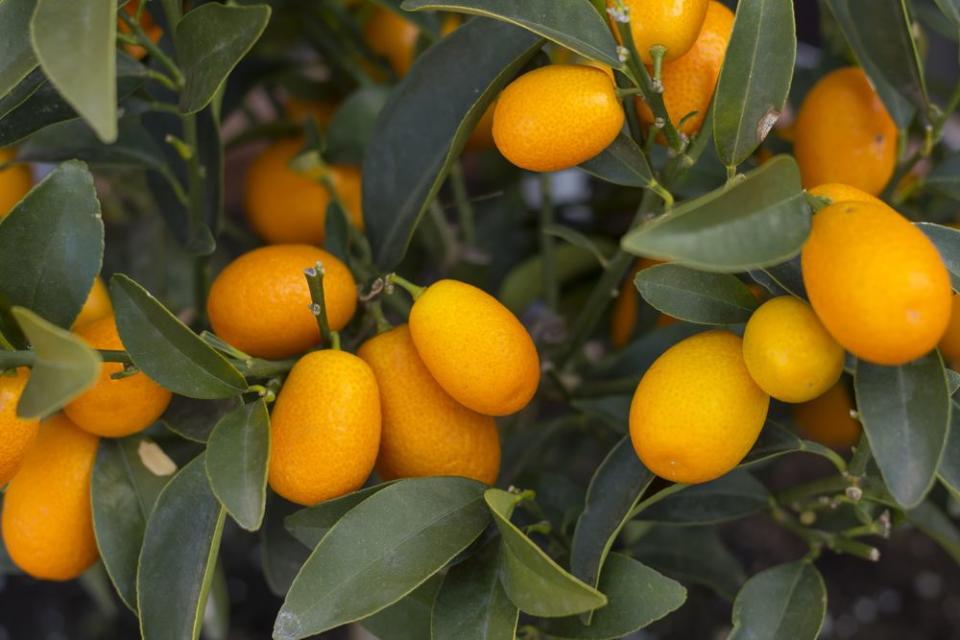What the Heck Is a Kumquat—and What Does It Taste Like?
The kumquat, funny name and all, might just be one of the most underrated and underutilized fruits of all time. Here’s everything you need to know about the little fruit with a big flavor:
What Is a Kumquat and Where Does It Grow?
A kumquat is an edible, orange-like fruit that is native to Southeast Asia.
Though the citrus fruit resembles an orange in shape and color, it’s actually quite small—about the size of an olive. Typically, kumquats are round or oblong.
The English name “kumquat” comes from a Cantonese word that means “golden orange” or “golden tangerine.”
We’re not sure how long the fruit has been cultivated, but the earliest known reference appeared in 12th-century China.
Though it has been a staple for centuries in Southeast Asian countries like China, Japan, India, and Taiwan, the kumquat wasn’t brought to Europe until the mid-1800s. By 1850, it was being cultivated in North America.
While the kumquat tree can survive low temperatures, it produces larger and sweeter fruits in warm climates. The tree’s temperament makes it ideal for growth in Florida and California.
Related: What Is a Persimmon and What Does It Taste Like?
Kumquat Varieties

There are a few varieties of kumquats, but the most common are Nagami and Meiwa:
Nagami: The Nagami Kumquat is the most common kumquat tree grown in the United States. The small, evergreen plant with dark green leaves is easy to care for. In addition to the fruit, the tree also bears white, sweet-smelling flowers. The Nagami is usually more tart than the Meiwa.
Meiwa: Meiwa Kumquats are more prevalent in China. It was introduced into the United States from Japan in 1910, but is still somewhat rare here, according to KumquatGrowers.com. The Meiwa is usually sweeter and rounder than the Nagami.
What Does a Kumquat Taste Like?
The kumquat’s flavor is distinctly citrusy. While the fruit is slightly sweet, the overwhelming flavor is sour and tangy.
The kumquat’s peel is surprisingly appetizing. In fact, the peel is the sweetest part of the fruit.
Related: Don't Toss Your Orange Peels—Make This Easy Marmalade Instead
How to Eat a Kumquat
Since the peel is edible, you always want to wash a kumquat before you eat it.
Once it’s good and clean, you eat a kumquat the same way you eat an orange: Just peel it (or don’t) and chow down. You can either eat the seeds or pick them out—eater’s choice!
How to Use and Cook With Kumquats

While they’re delicious raw, there are plenty of ways to enjoy cooked kumquats:
The kumquat’s sweet-yet-sour flavor makes it perfect for marmalades. As an added bonus, the fruit’s seeds contain pectin—this will make your marmalade extra thick.
Pickling preserves some of the kumquat’s sweetness and is shockingly easy to do.
The strong acidity in kumquats make them a great addition to rich meat dishes, particularly beef or lamb.
When they’re candied, kumquats make an excellent holiday gift or cocktail garnish.
Cooked into soup, the kumquat’s intense flavor begins to mellow as it softens.
Related: How to Pickle Almost Anything
When Are Kumquats in Season?
Kumquats are best when eaten from November to March. Always choose ripe kumquats. Look for firm, bright orange or yellow-orange fruits with blemish-free skin. Avoid greenish kumquats with shriveled skin.
Kumquat Nutrition
WATCH: How to Pickle
Though the kumquat is small, it packs a big nutritional punch. Rich in both vitamin C and fiber, kumquats give other, more well-known fresh fruits a run for their money.
Here are some of the kumquat’s nutritional highlights:
Rich in vitamin C (73% of the RDI in one 100-gram serving)
Rich in fiber (6.5 grams per serving)
Rich in antioxidants
Supports a healthy immune system
Relatively in calories (71 per serving) and may help combat obesity and related disorders
Hydrating (80% of the fruit’s weight is from water)
Where to Buy Kumquats
When they’re in season, you can find kumquats at farmers’ markets and specialty grocery stores. If kumquats aren’t available at a store near you (they are often relatively difficult to find in some areas), you can always consider growing your own plant indoors or outdoors, depending on where you live.
How to Store Kumquats
Unfortunately, kumquats are unlike other citrus fruits in that they don’t have a long shelf life. Their thin peels make them more vulnerable than oranges and lemons.
If you need to store kumquats for a few days, you can keep them in a paper bag on the counter at room temperature. They’ll do fine in an airtight bag in the refrigerator for up to a week.
Kumquat Recipes

Feeling inspired? Try your hand at one of our favorite kumquat recipes, from cocktails to dessert:

